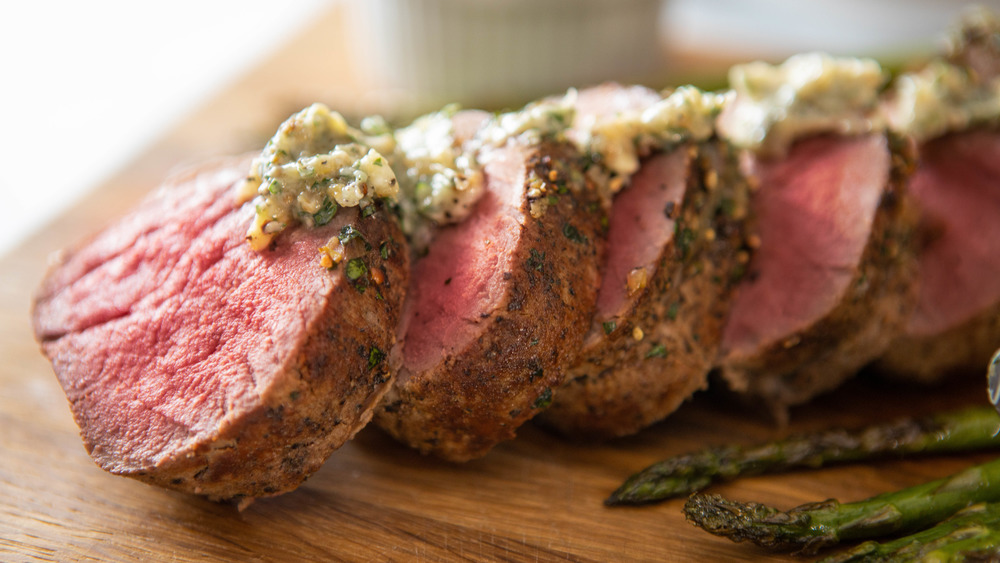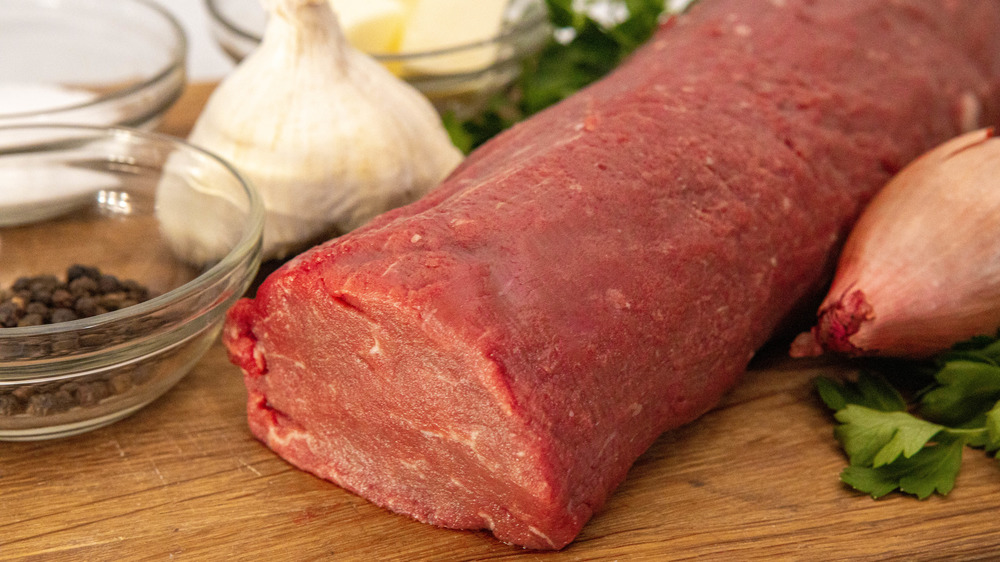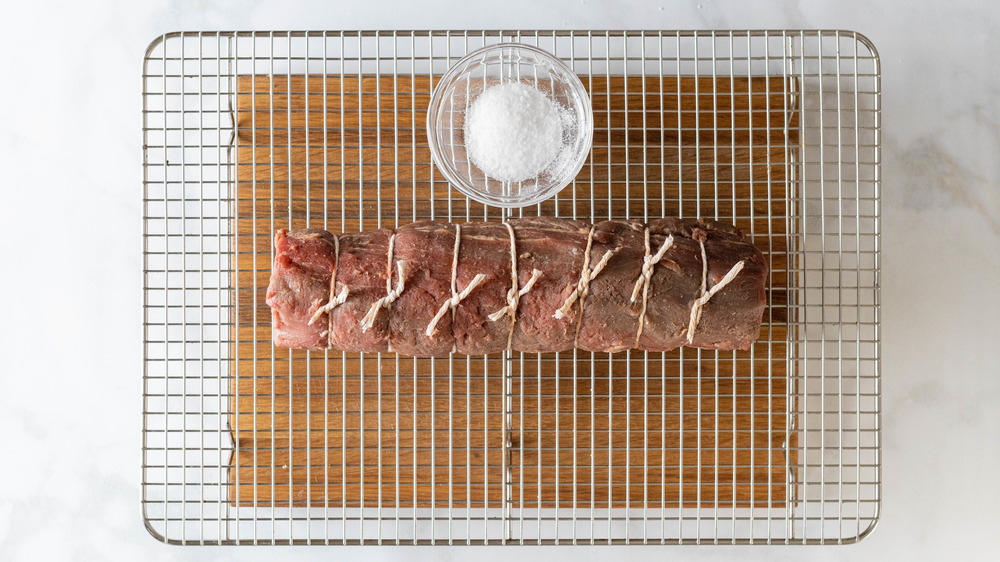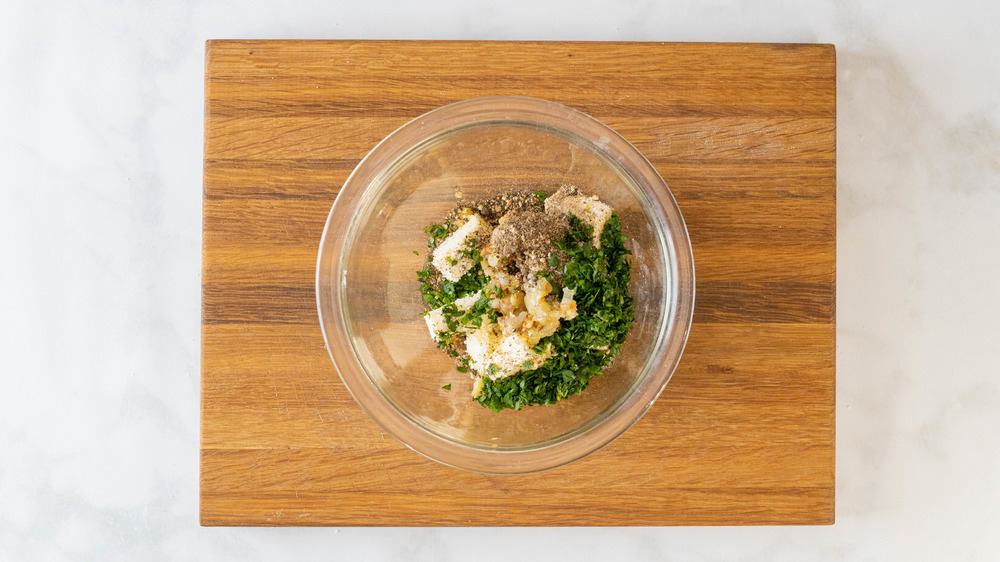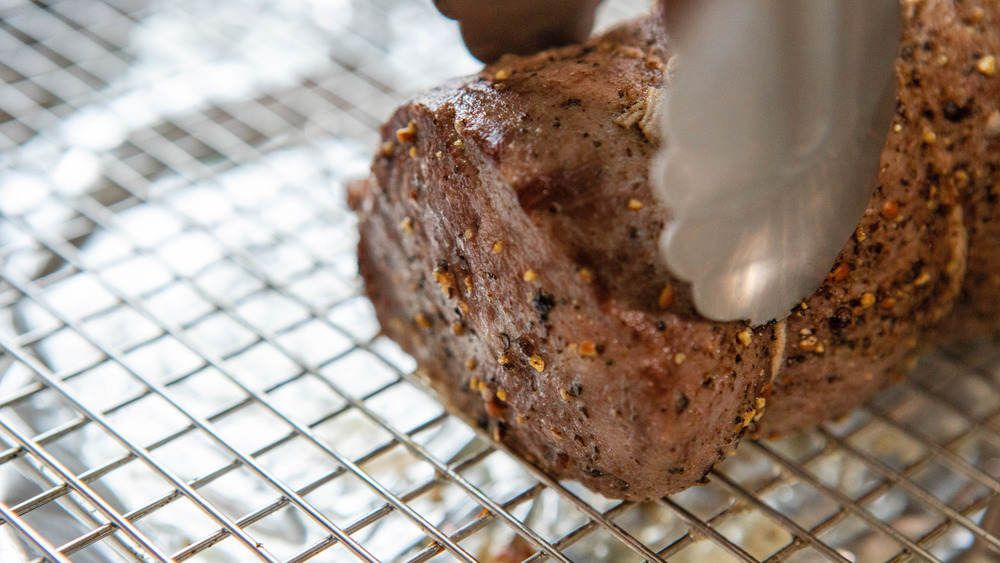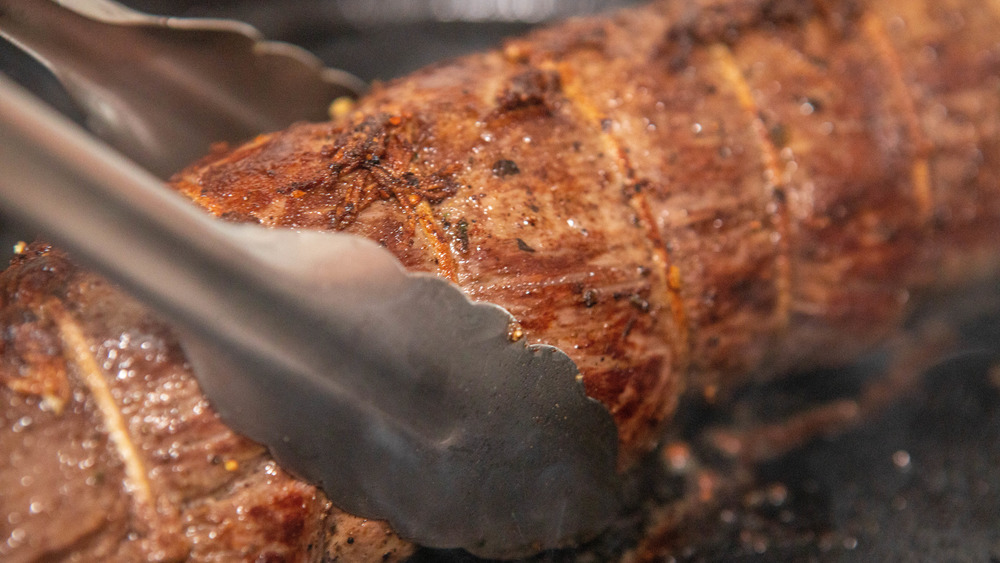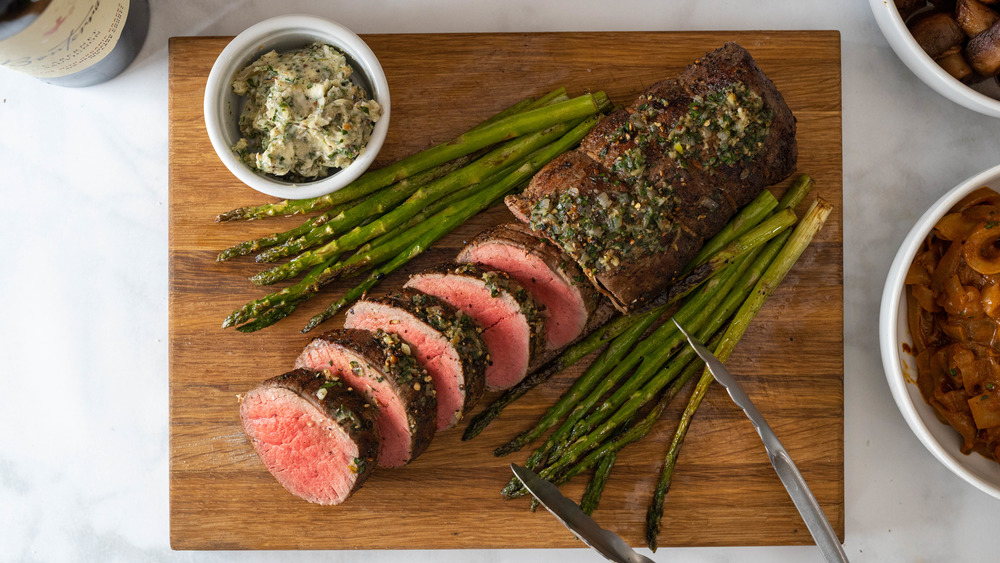Reverse-Seared Chateaubriand Recipe
We may receive a commission on purchases made from links.
You may be all set to dive into this classic French dish, but first things first: We've got to get the pronunciation right. Chateaubriand is pronounced "shah-tow-bree-and." If you're intimidated by this delightful entree, don't be. Chef and food writer Keith Kamikawa says: "I'd actually say, without being snarky, we could [call] this one 'shockingly easy' and it'd be completely true. It's really approachable. The only reason Chateaubriand could be intimidating would be the price."en what you pay for a cut of this meat, you really want that outcome!
As for how best to serve this top-quality meat, Kamikawa says, "This is a classic dish, so I love classic sides. Chateau potatoes, which are simply peeled potatoes cut into ovals roasted with fresh herbs and butter, are [perfect]. Burgundy mushrooms are a favorite too, as [is] seared asparagus."
And, as for when to splurge and serve this special meal? "Valentine's Day, anniversaries, birthdays, any excuse for a dinner for two is when [to] serve Chateaubriand," says Kamikawa. "Of course, if you want to share, the same thing holds true if you have a little larger group. It's easy and a fun project to work on together."
Gather your Chateaubriand ingredients
Depending on where you get your meat, this recipe may cost you anywhere between $100 and $200. Chateaubriand is essentially a large roast cut of fillet mignon, a popular cut of meat that can get pretty pricey. But, it's a meal you'll long remember and one that will thrill your special someone or your very fortunate dinner party guests.
You'll need 2 pounds of Chateaubriand (also known as center-cut beef tenderloin), softened unsalted butter, a shallot, garlic, coarse-ground black pepper, kosher salt, and chopped parsley.
Salt the Chateaubriand meat
Salting the Chateaubriand properly is almost as important as cooking it properly. That said, don't get too anxious here. Just take your time and follow the instructions, and you'll have the Chateaubriand ready to cook soon enough.
First, place the cut of meat on a wire rack over a pan or cutting board to help with cleanup. Evenly tie the tenderloin with butcher's twine, starting from the center and moving out to the ends. Then, rub the meat all over with the two teaspoons of kosher salt. Feel free to use more if a lot of the salt falls past the rack and misses the beef itself. Then, rest the meat in the refrigerator for at least 1 hour. If you can, rest the tied-up tenderloin for up to 24 hours. This will allow the salt to infuse its flavor into the meat.
Make the black pepper garlic butter for Chateaubriand
Mince the shallot and the 3 cloves of garlic, and then saute them in a small pan in ½ tablespoon butter. Cook until the shallots are translucent and the garlic becomes fragrant, or for about 2 to 3 minutes. Place the cooked shallot and garlic in a bowl and set it aside to cool.
In another bowl, mix 8 tablespoons of unsalted butter, 1 ¼ teaspoons of coarse-ground black pepper, a ½ teaspoon of kosher salt, and 2 tablespoons of chopped Italian parsley. When the shallots and garlic have cooled, combine them with the butter mixture, then set aside.
Begin cooking your Chateaubriand
Preheat your oven to 300 degrees Fahrenheit. Remove the meat from the fridge, let it sit at room temperature for 10 or 15 minutes, then pat the tenderloin with a paper towel to remove any moisture.
Next, rub the tenderloin first with a ½ teaspoon of coarse-ground black pepper and then with 2 tablespoons of unsalted butter, taking care to cover the entire tenderloin with both. Now, place the tenderloin on a wire rack on a baking sheet and bake it for 30 to 45 minutes, or until the center hits 115 degrees Fahrenheit for medium-rare (or 125 degrees Fahrenheit for medium), flipping and rotating the tenderloin halfway through baking.
Try to resist the urge to overcook this expensive cut of meat. Kamikawa says not to worry that those temperatures are well under "what you'd normally want, since you still have to sear the tenderloin after that [...] Once you're done searing, it'll be a perfect medium-rare."
Sear the Chateaubriand
Now it's time to get your sear on. Heat ½ tablespoon of vegetable oil in a heavy-gauge pan that's at least 10 inches in size. A cast iron pan is ideal for searing, though a heavy-bottomed pan that's suited for high heat, like a Dutch oven, can also work well here.
Heat the oil until it's beginning to smoke, then place the tenderloin in the pan and sear each side to an even brown color. This will take about 1 to 2 minutes per side. Lightly sear the ends, as well, by holding the meat upright with tongs — that sear should take only about 15 seconds.
Butter up the Chateaubriand and serve
Place the tenderloin on a cutting board and top it with 3 or 4 ounces of the black pepper garlic butter, then make a long tent over the top of the meat using aluminum foil. Let your precious Chateaubriand sit in that little tent for 10 minutes to let the meat rest.
Now, toss the tent, remove the butcher's twine, and slice the (perfect) meat into ½ inch thick sections. When you serve it, go ahead and top each cut with an additional dollop of black pepper garlic butter, as desired.
If there's any left over, there's no way that you're letting it go to waste. "For reheating," Kamikawa says, "I'd pull the tenderloin [from the fridge] and let it rest to room temp, get a nice and hot pan, [and] put a dab of butter in the pan for a quick sear. You could also do the same on nice hot grill."
When it comes to leftovers, think of all the ways you can add in new ingredients while still highlighting the meat itself. "This will [also] make an awesome cold or hot steak sandwich," says Kamikawa, "[but] my favorite is making a tenderloin eggs Benedict in the morning. That's some tasty steak and eggs."
Dishes that pair well with Chateaubriand
Reverse-Seared Chateaubriand Recipe
Chateaubriand is a classic meat dish that can intimidate, but never fear. This recipe will guide you to food greatness that will impress everyone at the table
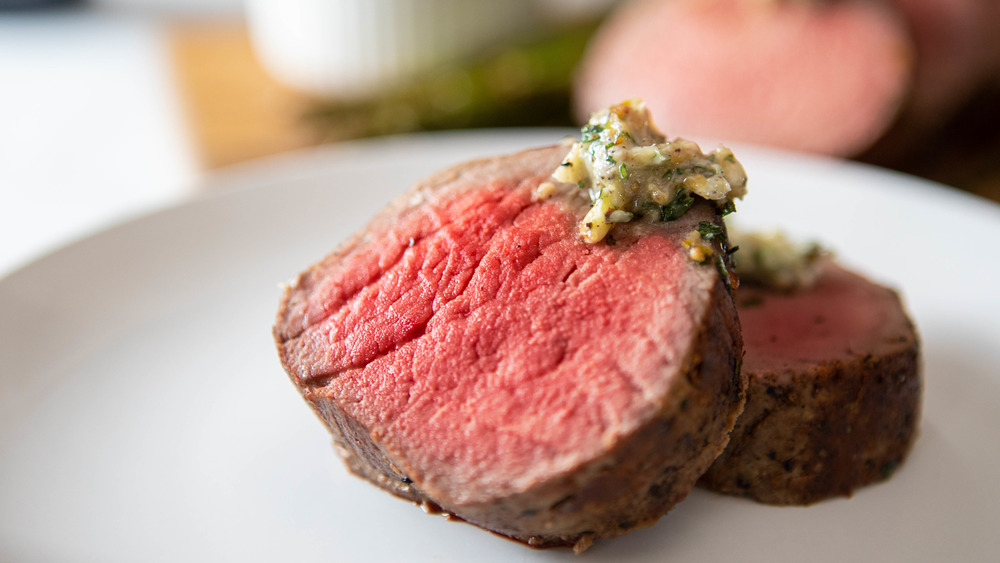
Ingredients
- 2 lb. Chateaubriand (center-cut beef tenderloin)
- 10 ½ tablespoons unsalted butter (softened)
- 1 shallot
- 3 cloves garlic
- 1 3/4 teaspoons coarse-ground black pepper
- 2 ½ teaspoons kosher salt
- 2 tablespoons chopped parsley
Directions
- Evenly tie the tenderloin with butcher's twine starting from the center out to the ends. Rub the tenderloin with 2 tsp of Kosher salt and rest in the refrigerator for 1 hour or up to 24 hours.
- Mince one shallot and 3 cloves of garlic, then sauté in ½ tablespoon butter until shallots are translucent, about 2-3 minutes. Set aside to cool. In a bowl mix 8 tablespoons of unsalted butter, 1 ¼ teaspoons coarse-ground black pepper, ½ teaspoon kosher salt, and 2 tablespoons of chopped Italian parsley. When the shallots and garlic cool combine with the butter mixture. Set aside.
- Heat oven to 300 degrees Fahrenheit. Pat the tenderloin with a paper towel to remove any moisture. Rub the tenderloin first with ½ teaspoon coarse-ground black pepper and 2 tablespoons of unsalted butter, covering the entire tenderloin. Place tenderloin on a wire rack on a baking sheet and bake for 30-45 minutes or until 115 degrees Fahrenheit for medium-rare doneness (125 degrees for medium). Flip and rotate the tenderloin halfway through baking.
- Heat ½ tablespoon of vegetable oil in a heavy-gauge pan at least 10 inches in diameter. Cast iron is ideal. Heat pan on high heat until the oil is beginning to smoke. Place tenderloin in the pan to sear each side to an even brown color, about 1-2 minutes per side. Lightly sear the ends as well, about 15 seconds.
- Place tenderloin on a cutting board and top with 3-4 ounces of the black pepper garlic butter. Tent with aluminum foil for 10 minutes.
- Remove the butcher's twine and slice ½ inch thick slices of the Chateaubriand to serve, top with additional black pepper garlic butter as desired.
Nutrition
| Calories per Serving | 562 |
| Total Fat | 47.2 g |
| Saturated Fat | 23.7 g |
| Trans Fat | 0.8 g |
| Cholesterol | 181.9 mg |
| Total Carbohydrates | 2.8 g |
| Dietary Fiber | 0.6 g |
| Total Sugars | 0.8 g |
| Sodium | 440.7 mg |
| Protein | 30.6 g |
What is the history of Chateaubriand?
Like many classic French dishes, the history of Chateaubriand is a little murky. The most popular story goes that the dish was created by a private chef in the 1800s for his employer, François-Auguste-René de Chateaubriand. It originally began as a large beef tenderloin (or, some argue, the sirloin) cooked in between two steaks, but modern recipes omit the latter element and just cook the center-cut tenderloin alone.
Classic recipes sear the meat before roasting it to medium-rare, and some even omit the roast and cook the meat entirely in a pan on the stove or on the grill. The method we use here reverse sears the meat, which allows for more control over the internal temperature and prevents the perfect sear from burning in the oven. Our garlic butter, too, is a departure from tradition, as the standard sauce choices are either red wine sauce or béarnaise. The star, though, is always the beef, and a hallmark of all Chateaubriand recipes is their penchant for simple presentations that avoid burying the protein's flavor.
